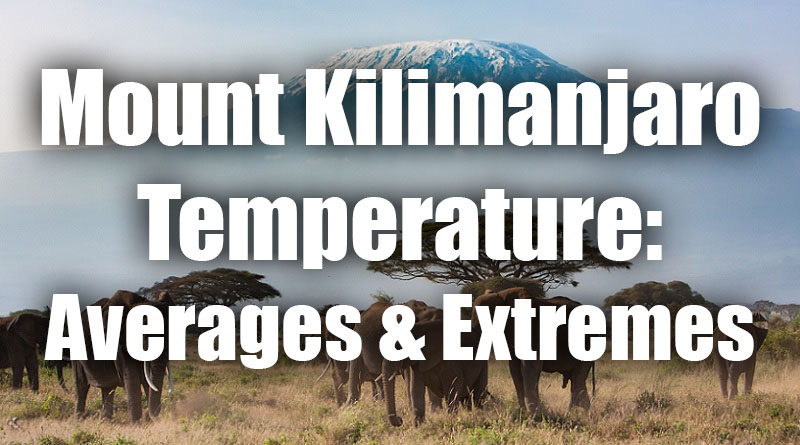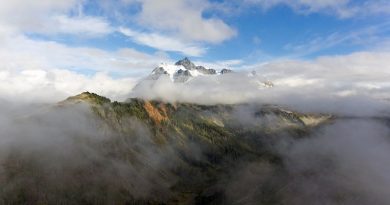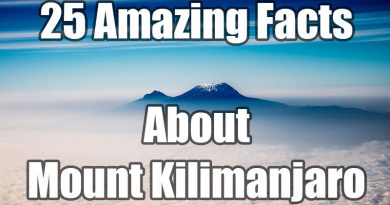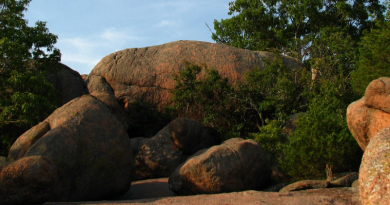Mount Kilimanjaro is the biggest tourist attraction in Kilimanjaro, bringing in around 30,000 travelers from around the world every year. If you’re looking to join the ranks of the men and women who have reached the mountain’s summit, you’ll first want to gain an idea of how hot and cold it generally is on the mountain. In this guide, we’ll go over the factors that influence temperature on Mount Kilimanjaro, as well as examine some specific temperature ranges you can expect during your climb.
Keep reading to find out how to better plan for the intense and volatile temperatures of Mount Kilimanjaro!

What Influences Temperature on Mount Kilimanjaro?
Let’s start off by taking a look at what influences temperature on the mountain. There are two main factors that contribute to Kilimanjaro’s temperature: time of year and altitude. We’ll examine each in turn to give you a better idea of what to expect when you go.
- Time of Year
Mount Kilimanjaro rests near the equator in Moshi, Tanzania. Due to its close proximity to this artificial line, temperatures remain surprisingly steady throughout the year. This means that you can expect a pretty steady temperature on the mountain on a month-by-month basis, though temperatures on the mountain aren’t without seasonal variation. In general, Kilimanjaro is warmer at the beginning of the year and takes a slight temperature dip around the middle of the year.
- Altitude
Knowing all this, it can be said that it is primarily altitude—and not season—that determines temperature on the mountain. Kilimanjaro boasts five different ecological zones that you will encounter as you trek up the mountain. Each contains its own climate characteristics, giving you different temperatures to plan for as you make your hike. In general, however, you can count on the bottom of the mountain being the warmest, with temperatures fairly similar to that of the surrounding city of Moshi. As you climb, the temperature will steadily drop and become increasingly unpredictable.
In other words, it’s best to talk about a range of temperatures the more you climb. While you can bet on a pretty constant 70 to 80 degrees F (21 to 27 degrees C) at the base of the mountain, temperatures closer to the summit can range anywhere from 20 and -20 degrees F (-7 to -29 degrees C). To prepare for this, you should pack both light and thick clothing so that you’ll be fit to climb under any circumstances.
Average Temperatures on Mount Kilimanjaro
With all this being said, there are some average temperatures that you can expect on Kilimanjaro. Before we get into specifics of temperatures on the mountain, let’s do a monthly breakdown of the average temperatures you can expect in the city of Moshi. Remember that you’ll have to prepare for these temperatures too if you plan on staying in the city any time before or after your climb:
| Average Monthly Temperature (Moshi) | ||
| Month | Temperature (F) | Temperature (C) |
| January | 78 | 26 |
| February | 78 | 26 |
| March | 78 | 26 |
| April | 76 | 24 |
| May | 72 | 22 |
| June | 70 | 21 |
| July | 69 | 21 |
| August | 70 | 21 |
| September | 71 | 22 |
| October | 75 | 24 |
| November | 76 | 24 |
| December | 77 | 25 |
As can be seen, the temperatures in Moshi remain fairly constant throughout the year. This means that you can expect to stay fairly warm in the city and should dress accordingly. As you can expect, the temperatures become much more interesting when you actually reach the mountain. For this reason, let’s break down the average temperature ranges by altitude so that you can better understand how to prepare for your climb.
Starting from the base of the mountain, you can expect temperatures between 80 to 95 degrees Fahrenheit. These temperatures dominate in the cultivation zone of the mountain, where villages, livestock, and plantations are commonly found. This zone lasts until around 6,000 feet in the air, with the temperature decreasing the higher up you climb.
From 6,000 to 9,000 feet in the air, you will encounter the rainforest zone, which features extremely dense foliage and vegetation and boasts temperatures in the 60 to 80 degree F range. In the moorland zone that follows, you can expect tons of grass land and temperatures that range from 40 to 60 degrees F. This zone lasts from 9,000 to 13,000 feet in the air and precedes the highland desert zone. The area is a lava desert filled with stone, remnants of Kilimanjaro’s volcanic past. The temperatures really begin to get cold here, ranging from 30 to 50 degrees F on average. The highland desert spans 13,000 to 16,000 feet in the air and comes before the final arctic zone. This area is by far the coldest on the mountain with temperatures ranging anywhere between -20 to 20 degrees F. if you make it to this area of the mountain, which towers into the air at 16,000 feet and above, you will certainly need extra winter clothes so that you do not suffer from frostbite or other negative side effects. The region of the mountain here is coated with ice and glaciers, making it beautiful to behold but treacherous to climb without the proper gear.
How Hot Does It Get on Mount Kilimanjaro?
Now that we’ve covered the average temperatures you can expect on Kilimanjaro and in the surrounding city of Moshi, it’s time to see just how hot it can get on the mountain. To do so, we’ll examine some record temperatures on the mountain to show you just what you may need to prepare for when you go.
The hottest temperatures invariably come at the base of the mountain, where the temperature and heat index can both hover around 100 degrees. Generally, you can expect temperatures in the high 90s at the hottest, though average temperatures around the base are closer to 80 degrees. Here, it’s okay to dress lightly, as you’ll have around 9,000 feet of warm to hot weather and high degrees of humidity that can make you sweat like a sponge.
How Cold Does It Get on Mount Kilimanjaro?
It can get pretty hot on Mount Kilimanjaro, but the same is true in reverse, as well—and perhaps even more so. Temperatures in the top arctic or glacial zone can dip down to -20 degrees F. In conditions such as these, frostbite can occur within thirty minutes. This means that, despite the low number of injuries and fatalities on Mount Kilimanjaro every year, extreme weather is a factor and should be a major part of your considerations as you plan for your climb.
What to Watch Out For
Don’t make the mistake of thinking that the temperature alone is what will influence your trip. Remember that added to temperature are other factors such as the heat index and wind chill factor which can put your body at strain if you don’t prepare for them. With a wind chill factor of -10 degrees F, for instance, you’ll find that Kilimanjaro is much colder than you may have anticipated, despite a temperature registering of 20 degrees F. For a more real world example, keep in mind that the wind chill has created conditions approximating -40 degrees F toward the mountain’s summit.
On the flip side, humidity and the heat index can make a hot 90 degrees F toward the base of the mountain feel more like 100 degrees. Keeping this in mind, it’s best to prepare for both factors and bring clothes that are suited to the most extreme conditions. Even if you don’t encounter these conditions yourself (and we hope you don’t), you’ll want to be prepared just in case.
Adding It All Together
From data above, there are a number of facts that we can gleam. For starters, we can tell that the warmest months on the mountain are January and February. This may come as a shock to those who are used to brutal colds during these two months, but it’s a natural result of Kilimanjaro’s proximity to the equator.
Conversely, traditional summer months (in the Northern hemisphere, anyway) June and July are the coolest on the mountain. During these times, you can expect average temperatures to take a bit of a dip, though you’ll still want to bring a mix of both light and thick clothing. Interestingly, though January and February are generally warmer months on the mountain, these two months see a higher percentage of snowfall at the mountain’s top zone than in June and July, when snowfall and precipitation in general are rare. In both cases, however, it’s critical that you prepare for brutal cold weather once you reach the top zones of the mountain.
Finally, remember that, while preparations for your own climb may depend slightly on the time of year you are going, the gear you’ll bring will essentially be the same. For this reason, it’s important to know how to dress appropriately to maximize your safety and your fun during your Kilimanjaro vacation.
How to Prepare for Mount Kilimanjaro Temperature
With that being said, what’s the best way to prepare for weather on the mountain? Simply put, there’s no better way than by dressing in layers. Layering is a system in which you strategically plan your attire to match the specific temperature and climate conditions of the mountain. As you climb, you’ll want to start with a general base layer that you can add onto in order to stave off the cold. Remember that it’s best not to wear cotton clothes, as the material is notorious for facilitating heat loss and making it harder to stay healthy during your climb.
Instead, opt for clothes that are made of polypropylene, silk, or wool, as these materials are great at trapping body heat and keeping you comfortable. Of course, you’ll want to find material that feels good against your skin and doesn’t bring about any adverse reactions.
On top of this base layer, which you will wear your entire time on the mountain (so choose wisely!), you can add a mid-layer of wool or fleece. If you are cold-blooded, you’ll likely want to choose fleece, as it has heavier insulating properties that will help you retain body heat and stay warmer on the mountain. You may opt for either synthetic or down insulation, with the latter providing the most warmth in cold conditions.
While the goal of the base and mid layers are to provide warmth, the outer layer also serves to protect wearers from external climate conditions such as wind and precipitation. For this reason, consider getting a heavy down jacket that is also waterproof. This will provide maximum protection from the brutal colds of the mountain and also keep you safer in the event of rainfall or snowfall.
Whatever the case, make sure to bring along enough clothes so that you are covered no matter how hot or cold it gets on the mountain.
The Bottom Line
As we’ve shown in this guide, weather on Mount Kilimanjaro can be brutal, fierce, and unpredictable. Of course, it can also be pleasant and enjoyable if you bring along the right gear. Located next to the equator, Kilimanjaro’s steady weather makes it easy enough to prepare for your next trip. Still, you’ll want to be sure that you are on top of the data so that you bring exactly what you need to make your climb a success. In this regard, it’s important that you get specific numbers and information that can help you plan your Kilimanjaro vacation.
In this piece, we’ve gone over the average temperature ranges you can expect on the mountain, as well as examined record highs and lows. We’ve also broken down Kilimanjaro temperature by altitude so that you an get a better picture of conditions on the mountain. By taking into account the information presented here, you’ll be able to best the odds and reach the top of the mountain without any extra hassle or delay. Knowing all this, make sure to use this guide as your ultimate reference for preparing for your Kilimanjaro trip.






